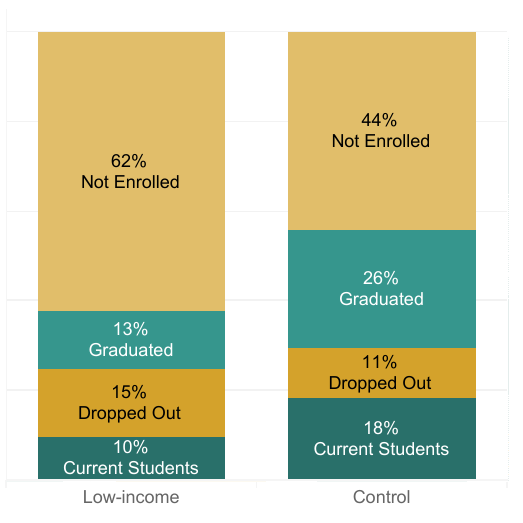The latest UDRC study on post-secondary outcomes for low-income students
Karen Tao, Senior Researcher
October, 2022

The latest research from the Utah Data Research Center (UDRC) uses data from the Utah State Board of Education (USBE) and Utah System of Higher Education (USHE) to examine post-secondary outcomes for low-income students from Utah high school cohorts from 2012 to 2014. This study focuses on low-income students' education outcomes to develop a deeper understanding of the challenges they face as they pursue post-secondary education.
This study defines low-income as the eligibility to receive free or reduced lunch benefits. For each student, the low-income status is collected from the last enrollment record in USBE data. Those who were eligible to receive free or reduced lunch benefits in high school according to their last high school enrollment were the “low-income” students in this study. In contrast, high school students who were not eligible for free or reduced lunch benefits as of their last high school enrollment were considered the control group for this research. Understanding low-income students’ postsecondary outcomes may be valuable as 30% of the students in this study met the criteria for being considered low-income. Education is an important component of human capital, and education attainment could increase productivity as well as long-term wages. Completing any post-secondary program is associated with higher wages and increased general consumption. This increase in consumption benefits the state from increased economic activity and potential sales tax revenue.
Statistical tests were applied to study the relationship between low-income status and various post-secondary outcomes, including enrollment, cumulative GPA, award, drop-out pattern, time to enrollment, time to award, and time to drop out.
This study finds that the post-secondary enrollment and award rates are significantly lower for low-income students compared to the control group. For all low-income students, 38% enrolled in post-secondary education, while 56% of the control group enrolled in a post-secondary institution.
In addition, among students who enrolled at a degree-granting institution, low-income students experience a significantly longer time to enroll, lower GPA, and higher drop-out rates. The length of time to enroll at a degree-granting institution is statistically significantly longer for low-income students than for the control group.
In contrast, this study found no significant difference in time to enrollment or time to certificate at technical colleges between low-income students and the control group. For all students who enrolled at a technical college, it took 2.6 years on average for low-income students to enroll after high school completion, while it took 2.7 years on average for the control group to enroll.
Finally, low-income students enroll at and graduate from post-secondary institutions at a lower rate than their peers . Among all students, the proportion of low-income students who did not enroll in post-secondary education is strikingly larger than the proportion of the control group. Only 37.7% of low-income students enrolled in postsecondary education versus 55.7% of students who did not experience low-income disadvantage.

The findings from this study suggest that low-income students with sufficient knowledge about their educational options and resources to pursue a post-secondary award could achieve the award in a similar timeframe as their peers. This study further highlights the loss of low-income students beginning at high school completion. Fewer low-income students enrolled at post-secondary institutions, and even fewer obtained a post-secondary award. Drop-out rates among low-income students were significantly higher than their peers. Lack of post-secondary education may impact long-term earning potentials for these low-income students and subsequently their upward mobility. To learn more, visit the interactive data narrative and access the complete research report.